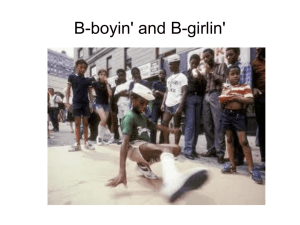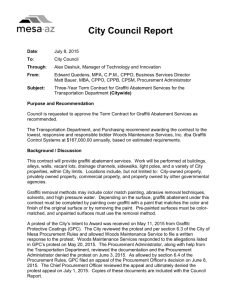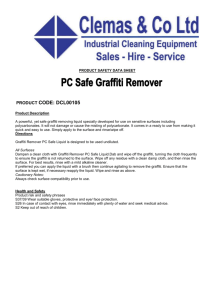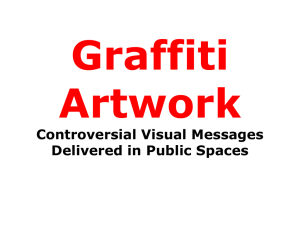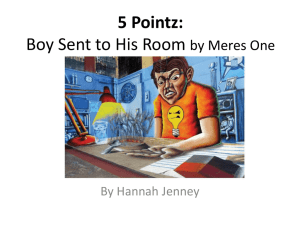GRAFFITI
advertisement
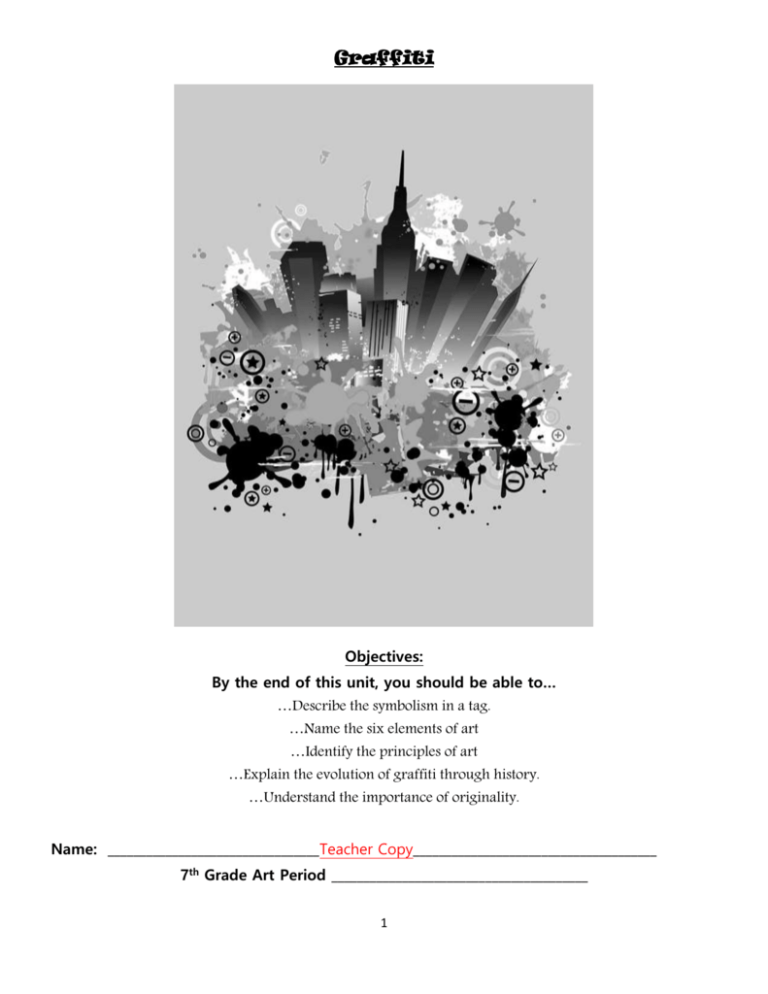
Graffiti Objectives: By the end of this unit, you should be able to… …Describe the symbolism in a tag. …Name the six elements of art …Identify the principles of art …Explain the evolution of graffiti through history. …Understand the importance of originality. Name: _________________________________Teacher Copy______________________________________ 7th Grade Art Period ________________________________________ 1 GRAFFITI: LEGAL ART vs. ILLEGAL VANDALISM -ask permission or be commissioned -done without permission -tourist attraction -people don’t like the subject matter -designs on clothing, shoes, etc. -both are done by are influenced by graffiti an artist -can be paid to create graffiti -both want to send a -trains and subways -can get into trouble; fined or jail time -sends a gang vibe message Lesson 1: What is Graffiti? Graffiti originally referred to the inscriptions and markings found on the walls of ancient ruins: o Greece o Mayans o Rome o Prehistory- Cave men o Vikings o Soldiers during war o Ancient Egypt o Renaissance artists GRAFFITI: any type of marking inscribed onto any surface, whom some regard as vandalism; can be legal or illegal “From the womb to the tomb, we as human beings have had the need to create4 and mark our territory. We need to let the rest of the world we are here. This is the true foundation for graff writing.” ~Scape 2 1960’s: CORNBREAD and COOL EARL began leaving their signatures everywhere in Philadelphia, PA. 1971: Signatures began popping up in NYC. o TAKI 183 was one of the first artists to get media attention. After an interview, hundreds of kids began writing their TAGS, or name, all over NYC. The timeline between 1969 and 1974 is known as the pioneering era, when graffiti experienced a surge in style and popularity. 1980’s: Graffiti from NYC began to spread worldwide due to hip hop subculture: o Music videos o Movies and film “Why are we attracted to graffiti? I believe that part of it has to do with what I call the psychology of self-affirmation. There is something inside us that wants to take up space and proclaim our existence. Graffiti has always been about rebellion, style and observation.” ~Scape Graffiti is now considered an American art form and it influences the work of individuals in many areas: o Graphic design o illustration o advertising o technology o photography o fine arts FAMOUS GRAFFITI ARTISTS: TAKI 183: Manhattan teenager (NYC), his name and street #. Taki = Greek for Demetrius, 183 was his house number. ILLEGAL GRAFFITI. He did it for himself as a way to say “I was here!” Did not use real name so he wouldn’t get into trouble; no one knew who he was until a few years ago. KEITH HARING: Born in Pennsylvania, 1958. Went to NYC School of Arts; noticed the empty black panels in the subways and began writing on them with chalk. Was arrested numerous times. Eventually began to use his graffiti style of dancing figures with graphic design legally to create posters and such to spread a message. Died in 1990. ILLEGAL THEN LEGAL GRAFFITI. BANSKY: Began in early 1990’s with graffiti gang Dry BreadZ crew. Frde hand and stencil graffiti style until late 90’s when he used all stencils. From London, England. Images with slogans, often with political theme. Real identity is unkown. ILLEGAL GRAFFITI, but people accept his graffiti, unlike other illegal graffiti artists. SCAPE MARTINEZ: Born in New Jersey; lives and works in San Francisco. Grew up around graffiti and began to use it to express himself. Very large scale, colorful art. Is commissioned to create public art, murals, etc. Is a writer and an art educator. Gets paid to graffiti. LEGAL GRAFFITI. 3 Lesson 2: What is a Tag? ORIGINALITY: Creating something that is your own; using imagination and creativity to create an individualized end product PLAIGARISM: Copying someone else’s work without permission and without giving credit to the original creator TAG: A tag is more than just your name, it’s your identity; it’s a visual manifestation of your alter ego. In graffiti art, your tag is usually the main focus of your art. It’s your logo. When choosing a tag, think of the following: 1. How does it sound? a. What does it make you think of? b. REVOK vs. SLICK 2. How does it look when it’s written? a. How do the letters look when written together? b. Is there rhythm to the way your letters look? 3. Length a. Don’t make your name too big b. Short and to the point c. Ideally, no more than 6 letters 4. What does your name mean? a. Sometimes it doesn’t mean anything, just sounds cool b. Some names stand for a hidden meaning 5. Numbers? a. Early artist’s incorporated numbers, which stood for the street number they lived on…i.e. 125th street in NYC = SCAPE 125 b. Numbers can be used for purely a design element…i.e. MODE 2 6. Some other tips: a. Double A’s and E’s promote balance b. Q, X and Z are letters that are often difficult to work with c. Be creative with spelling i. Interchangeable letters (C and K) ii. ESCAPE became SKAPE, which was finalized to SCAPE 7. CREATE A LIST OF POSSIBLE TAG NAMES BELOW: 4 Lesson 3: Elements and Principles of Graffiti Tags can be broken up into four basic elements: LETTER TEXT The actual letters in the name / tag. ARROWS Any kind of marks that point or provide a sense of directions; often connected to the letter text FLOURISHES SYMBOLS Added swirls, appendages, or expressions onto Separate marks and expressions that represent letter text. text. the letter structures; often connected to the something else; not connected to the letter A graffiti artist thinks a lot about the COMPOSITION of his or her tag. There needs to be flow and purpose to the way it is put together. Each tag incorporates the elements and principles of art in some way, shape or form. 5 GRAFFITI STYLES BUBBLE LETTERS: Easiest to read and create BLOCK LETTERS: Straights; uses straight lines; may also be 3-D SEMI-WILDSTYLE: Semi-readable; very stylized; uses arrows and flourishes. WILDSTYLE: Not very legible; viewer may only be able to read a letter or two; style and execution is very important. 6


